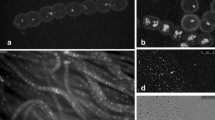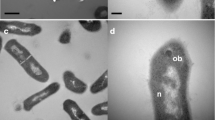Abstract
An oleaginous hydrocarbon-degrading Rhodococcus opacus strain (PD630) was isolated from a soil sample. The cells were able to grow on a variety of substrates and to produce large amounts of three different types of intracellular inclusions during growth on alkanes, phenylalkanes, or non-hydrocarbon substrates. Electron microscopy revealed large numbers of electron-transparent inclusions with a sphere-like structure. In addition, electron-dense inclusions representing polyphosphate and electron-transparent inclusions with an elongated disc-shaped morphology occurred in small amounts. The electron-transparent inclusions of alkane- or gluconate-grown cells were composed of neutral lipids (98%, w/w), phospholipids (1.2%, w/w), and protein (0.8%, w/w). The major component of the cellular inclusions was triacylglycerols; minor amounts of diacylglycerols and probably also some free fatty acids were also present. Free fatty acids and/or fatty acids in acylglycerols in cells of R. opacus amounted up to 76 or 87% of the cellular dry weight in gluconate- or olive-oil-grown cells, respectively. The fatty acid composition of the inclusions depended on the substrate used for cultivation. In cells cultivated on n-alkanes, the composition of the fatty acids was related to the substrate, and intermediates of the β-oxidation pathway, such as hexadecanoic or pentadecanoic acid, were among the acylglycerols. Hexadecanoic acid was also the major fatty acid (up 36% of total fatty acids) occurring in the lipid inclusions of gluconate-grown cells. This indicated that strain PD630 utilized β-oxidation and de novo fatty acid biosynthesis for the synthesis of storage lipids. Inclusions isolated from phenyldecane-grown cells contained mainly the non-modified substrate and phenylalkanoic acids derived from the hydrocarbon oxidation, such as phenyldecanoic acid, phenyloctanoic acid, and phenylhexanoic acid, and approximately 5% (w/w) of diacylglycerols. The lipid inclusions seemed to have definite structures, probably with membranes at their surfaces, which allow them to maintain their shape, and with some associated proteins, probably involved in the inclusion formation.
Similar content being viewed by others
Author information
Authors and Affiliations
Additional information
Received: 22 December 1995 / Accepted: 12 March 1996
Rights and permissions
About this article
Cite this article
Alvarez, H., Mayer, F., Fabritius, D. et al. Formation of intracytoplasmic lipid inclusions by Rhodococcus opacus strain PD630. Arch Microbiol 165, 377–386 (1996). https://doi.org/10.1007/s002030050341
Issue Date:
DOI: https://doi.org/10.1007/s002030050341




